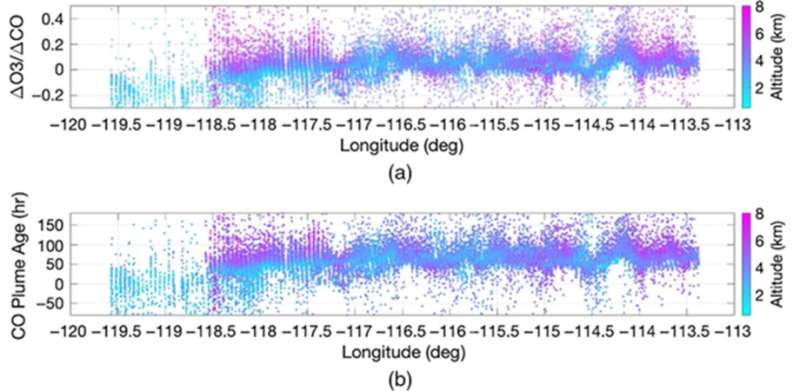Understanding the effects of wildfires on air quality

Wildfires, characterized by unplanned, uncontrolled, and unpredictable fires erupting in areas such as forests, grasslands, and prairies, have recently grown in frequency and intensity. Likely resulting from climate change effects, wildfires are increasingly impacting ecosystems and human lives. While wildfires are considered ecologically beneficial, there have been rising concerns over the negative effects, namely degradation of air quality from the smoke and pollutants released.
In particular, carbon monoxide (CO) and ozone (O3) are major contributors to wildfire-induced air pollution. However, unlike CO, O3 is not directly generated during wildfires. Instead, it is produced from O3 precursors emitted during wildfires and depends on several factors for its production. This, in turn, complicates the O3 production process. Moreover, its presence within wildfire plumes determines the wildfire plume age. Assessing its concentrations is therefore necessary to better understand how wildfires affect the air quality, weather, and climate.
In a recent study published in the Journal of Applied Remote Sensing, scientists at NASA Langley Research Center, in collaboration with the National Oceanic and Atmospheric Administration (NOAA), reported their findings on this front in the Fire Influence on Regional to Global Environments and Air Quality (FIREX-AQ) field campaigns in 2019. The measurements of atmospheric CO and O3 levels were performed across the continental U.S. using a remote sensor called “National Airborne Sounder Testbed-Interferometer” (NAST-I), which provided both high spatial and spectral resolution.
“The NAST-I, onboard NASA ER-2 aircraft, covers a space large enough to monitor the wildfire plume from its origination, evolution and transport, and provides 3D distributions of the O3 and CO concentrations at a higher spatial resolution compared to that of satellite infrared-ultraspectral sensors,” said Dr. Daniel K. Zhou, the principal investigator of NAST-I and the lead author of the study.
Based on these measurements, the team estimated the plume age by observing the differential concentration ratios of O3 and CO, i.e., ΔO3/ΔCO and performing a linear fit with previous observations of wildfire ΔO3/ΔCO ratios. “Our results showed enhanced levels of CO in the evolving plume as it was transported away from the site of the fire. The plume age was associated with the plume distance in both vertical and horizontal directions,” Zhou said.
Overall, this study provides important insights that could prove crucial to a deeper understanding of the effects of wildfires on the atmosphere and the steps needed to mitigate them.
Western wildfire smoke plumes are getting taller
Daniel K. Zhou et al, Estimation of fire-induced CO plume age from NAST–I during the FIREX-AQ field campaign, Journal of Applied Remote Sensing (2022). DOI: 10.1117/1.JRS.16.034522
Citation:
Understanding the effects of wildfires on air quality (2022, September 7)
retrieved 8 September 2022
from https://phys.org/news/2022-09-effects-wildfires-air-quality.html
This document is subject to copyright. Apart from any fair dealing for the purpose of private study or research, no
part may be reproduced without the written permission. The content is provided for information purposes only.
For all the latest Science News Click Here
For the latest news and updates, follow us on Google News.

